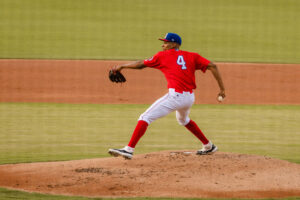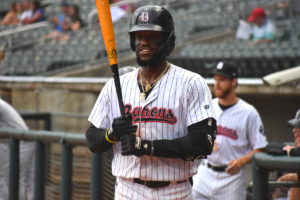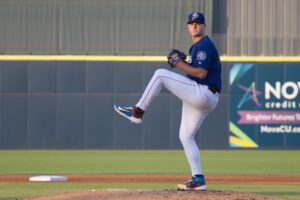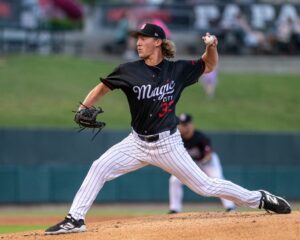Next Wave: Pitchers who just missed our midseason top prospects list
After we publish our twice-annual Top Prospects lists, we also publish a pair of follow-up articles we call the “Next Wave.” One covers position players, which we published yesterday here. This one covers pitchers. These are prospects who didn’t make our most recent top 30, but who are nonetheless worth keeping an eye on.
You may be asking yourself, “Are there really prospects worth watching who aren’t even among the White Sox top thirty guys?” If you are, I’ll answer with an illustration.
Looking strictly at pitchers, in the last 2 editions of these Next Wave articles, four of the arms we discussed have since made the Top 30 list, and a fifth (Yency Almonte) would have had he not been traded away. Three have reached the majors (two of those with the White Sox). Some others are here on this list again. In other words, it’s not uncommon for players to be just off the radar who pop up later and could even be major league contributors.
Who will jump out from under the radar this time? Here are nine possibilities on the pitching side, which fall into three categories (but not in any specific order in each section)…
Close to the majors
With Zach Duke traded away, the club is likely to have a need this year and possibly next for a lefty specialist. Also known as a LOOGY (Lefty One Out GuY), Will Lamb seems to fit the bill. Acquired in the offseason in a prospect-for-prospect trade for Myles Jaye (who had been ranked as high as 17th in the White Sox system at one point), Lamb has been very effective against left-handed hitters despite pitching in a hitting-friendly home environment. They are posting an anemic .132/.220/.208 line against him and he’s only allowed one home run. The 6’6″ 25-year old could be in Chicago pretty soon.
Peter Tago is currently in AA, but that didn’t stop Michael Ynoa or Carson Fulmer from going to the majors. Tago was a minor league phase Rule 5 pick last year, was significantly re-tooled by the Sox coaching staff, and then went from A to A+ to AA that season. Here in 2016 after a rough opening, in the May through early August period he’s been put up some big numbers: 1.96 ERA, 1.06 WHIP, 12.3 K/9 (though he’s been roughed up a couple times lately). The new Tago throws a fastball in the 93-95 range with noticeable life, and two slider variants. We’ve been told the White Sox are taking a serious look at him for a September call-up.
Brad Goldberg looked buried at one point as a 24-year old in High A ball, but he’s in AAA now and looking like a potential bullpen option for the White Sox. Brad got himself in better athletic shape and tweaked a few things, and now has a fastball that can reach the upper 90’s. So far with AAA Charlotte, he’s showing a decent strikeout rate and getting plenty of ground balls when he doesn’t get a whiff, which is a good combination for summers at US Cellular Field.
Young guns
The team’s 5th round pick this past June, Jimmy Lambert has been impressing in his professional debut. Between the rookie-level AZL and Class A Kannapolis, he’s put up these numbers: 3.00 ERA, 1.22 WHIP, 2.7 BB/9, 10.7 K/9 in 27 innings. He’s mostly been starting, but on a pitch limit restriction, so his starts have typically lasted just 2 to 4 innings. But the fact that the 21-year old is throwing strikes and missing bats at these rates in full season ball already is encouraging.
Blake Hickman went down for Tommy John surgery shortly after he was drafted in the 7th round in 2015. The plan was for him to get into games perhaps late this season, but so far he hasn’t made it back to full play (though he is now throwing off a mound and getting close to ready). Prior to surgery, the right-hander had a mid-90’s fastball, sharp slider and plus athleticism. Look for Hickman to get some innings in fall instructs, and maybe even throw in winter ball somewhere before joining an affiliate next spring.
Chris Comito was taken in the 15th round in 2015, but was signed for a bonus more in line with the 8th round. There was some hype around this prep draftee, but he struggled in 9 starts in an aggressive assignment to Kannapolis as a 19-year old (6.48 ERA, 1.63 WHIP, 2.4 BB/9, 5.8 K/9). Now back in Great Falls under the tutelage of Matt Zaleski, Comito performed looked much better in June and July: 2.74 ERA, 1.05 WHIP, a scant 1.3 BB/9 and striking out a batter per inning in seven starts. This 6’6″ hurler is young and his stuff is still evolving.
Taylore Cherry has taken an unusual path. The 6’9″, 280 pound reliever left the UNC baseball team in the spring of 2015 and didn’t pitch competitively that year, and was taken in the 32nd round anyway by the White Sox on a flyer. After struggling with control in his draft year (unsurprisingly), this season he’s throwing strikes (1.9 BB/9 across both A-ball clubs) and missing quite a few bats (9.3 K/9 with Kanny) leaning mostly on a big fastball in the mid-90’s. He was recently promoted to a more age-appropriate level at Winston-Salem and seems to be catching up.
Gradual climbers
Thaddius Lowry has been either at the back end of our Top 30 prospects lists or just outside of them for most of his pro career. There are tools to dream on: a mid-90’s sinker he can locate, a slider that at times shows significant 2-plane movement, a strong pitcher’s frame and premium athleticism. The numbers have not typically matched the potential, but this year in Advanced-A he’s having the best season of his career, giving up fewer hits and striking out more batters than he has since his draft year while still throwing strikes. An improved change-up seems to be the difference maker. It’s important to note that Lowry is still just 21 and a couple years younger than the average pitcher in his league.
Connor Walsh makes the radar for a specific reason – he’s got a fastball that can reach upper 90’s with serious movement. The problem is with control. In 2015, Walsh struck out 79 and only allowed 39 hits in 53 innings, but he also issued a whopping 44 free passes (that’s the rare more walks than hits allowed trick). Here in 2016 he’s in the zone much more often, lowering his BB/9 from 7.5 to 4.2, though he’s now “only” striking out a little over a batter an inning. If he can throw strikes consistently, with that fastball, he doesn’t need super-precision command to be successful.
Want to know right away when we publish a new article? Type your email address in the box and click the “create subscription” button. Our list is completely spam free, and you can opt out at any time.






